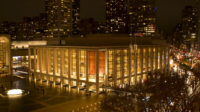Designed by Jack Diamond of the Toronto-based Diamond Schmitt Architects, the new 851,575-square-foot, seven-story building expands the institution’s campus in the historic heart of the city: the original Mariinsky Theater (1860), home to the renowned opera and ballet companies, and a recently built concert hall (2006) by Xavier Fabre. Its size and scope may well fulfill Gergiev’s goal to create a premier performing-arts complex capable of mounting demanding productions. But there is nothing excessive about Diamond’s plan, which won the second of the competitions in 2009. An opera lover who caught Gergiev’s attention with the superior technical performance of his Four Seasons Centre in Toronto, the architect emphasized program above all.
Respecting the context of the city’s architecture and plan, Diamond devised a generously glazed, limestone-clad opera house with a wood-lined auditorium that accommodates nearly 2,000 seats. An enclosed bridge for people and props connects it to the existing 1,600-seat theater, a Rococo gem a third of its size, on the opposite side of the Kryukov Canal. Tests by theater consultant Fisher Dachs and acoustician Müller-BBM indicate excellent sightlines and acoustics, while state-of-the-art production facilities and daylit rehearsal studios for both houses aim to elevate the outdated venue to one of the world’s best.
Yet despite reports of a first-rate interior, local residents have been sounding off about the building’s exterior with petitions to have it razed before it’s even completed. According to the city’s English-language newspaper, the St. Petersburg Times, preservationists say it conflicts with its traditional surroundings. At the same time, architects think it is too plain. “Any contemporary building—any building, for that matter—introduced into historic St. Petersburg is subject to criticism, whether justified, informed, or not,” said a Mariinsky representative in an e-mail. “Our expectations are more than being met. Once it is complete and people experience it, their impressions will change.”
Ironically, the current protests follow a trail of similar reactions to previous schemes. The first to be considered, in 2002—a radical design by California architect Eric Owen Moss—was swiftly defeated for its imposing, crumpled-glass facade and programmatic limitations. One year later, the jury of an invited competition awarded the commission to French architect Dominique Perrault for a design that had the makings of an icon—a golden domelike structure enveloping a marble opera house. Plagued by client indecision, construction issues, and extreme budget overruns, this project was scrapped in 2007 despite the fact that the foundation was under way.
With an accumulated cost of approximately 21 billion rubles (about $700 million), funded by the Russian government, the Mariinsky II may be one of the most expensive cultural projects ever built—though the late Jørn Utzon’s Sydney Opera House (1959–73) rivals itsexpense, duration, and stress.
Frustrated by the turmoil, Diamond defends his scheme, explaining, “We were pushed by the minister of culture at the beginning of the job to make a classical exterior with a modern interior, but I said, ‘No, one should have a relationship to the other.’ ” He was also against overpowering the area’s “independent jewels”: the old Mariinsky, scheduled for future renovation, and the nearby St. Petersburg Conservatory of Music (c. 1890). Instead, the architect says he worked to frame them, using the principles of the past—maintaining the street continuity, the scale, and classic elements, such as a masonry base and metal roof. “Every architect wants his shot at doing an extravagant building,” says Diamond. “But it would be inappropriate here.”













Post a comment to this article
Report Abusive Comment